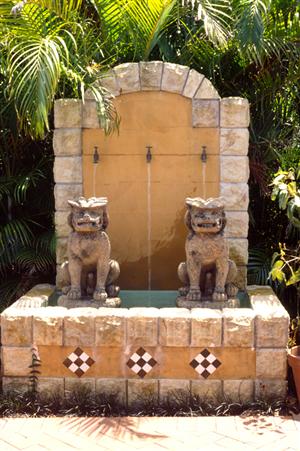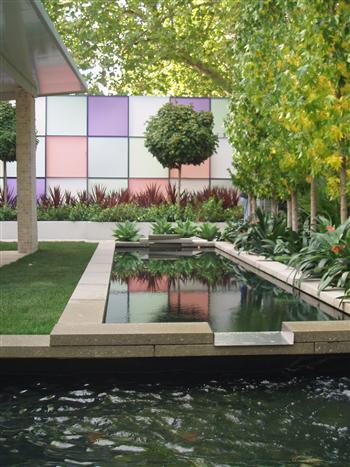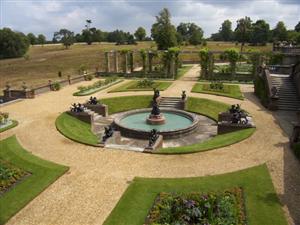Water Gardens
|
Water adds something very special to any garden. It is a feature like no other, that can bring movement, sound and sparkling light into the garden, as well as giving a refreshing sense of coolness, and attracting wildlife.
Water gardens come in many different forms, and are capable of lifting any size garden into a new dimension.
|
Learn to Design and Create Water Gardens
with our 100 hour Distance Education Course
click here for details
|
 A water garden can be as simple as a small tub or wall fountain; or as complex as a stream with a series of cascades and waterfalls.
A water garden can be as simple as a small tub or wall fountain; or as complex as a stream with a series of cascades and waterfalls.
You can introduce a simple water feature to your garden for less than $100; or spend tens of thousands of dollars to create a large pond with fountains and waterfalls.
Do you want live or sterile water?
Live water has things growing in it, ie. plants and animals. This can include fish, snails, frogs, insects and various types of water plants. These living things need to be kept in balance otherwise the water can become unhealthy; it may be overtaken by water weeds, animals may die and eventually it can become stagnant.
If you plan a living water feature properly; it largely looks after itself. If you don’t, it may breed mosquitoes, disease and develop undesirable smells.
Non living water is water that is kept clean by treatments such as chlorine or salt. This water is clean and sparkling (provided the treatments are maintained), and it does not produce smells.
 Options
Options
While there is a huge variety of water features your options will mainly be determined by space, budget, time available for maintenance, and the style of your garden.
A body of still live water
A body of still live water, such as a pond, lake or dam, is obviously best suited to large properties and will initially have high establishment costs. The size of the pond or dam must be in keeping with the surrounding landscape – a small pond will have no aesthetic impact in a large rural setting, for example. The siting of the pond is also important – in natural settings water collects at the lowest point. This is where you would place a pond in an informal garden.
Still non-living water, eg. swimming pool or water feature
The most important thing to remember about a pool is that its prime function is to swim in. This means that it must be functional, it will be expensive to install, it will have high ongoing maintenance, and it must conform to safety requirements. Shape, surface materials and surrounding plantings will help to blend the pool into your style of garden.
You may also utilise still non-living water as an aesthetic component to a garden design. Stylistic modern homes are more suited to this type of water feature, which are generally constructed with strong geometrical shapes and forms.
 Fountains
Fountains
Traditionally, freestanding fountains have been very popular for gardeners. These are best suited to formal gardens or as the centrepiece in a large courtyard. They are usually set in a round or square pond which needs to be large enough to catch the spray.
Wall fountains are becoming more popular, especially in courtyards, because they take up less space. They are readily available in kit form, which includes a pump, from most garden centres and hardware shops. Their ease of installation and aesthetics make them well suited to modern garden designing.
Watercourse
A watercourse, such as a stream, a series of cascades, or a waterfall, is one of the more exciting water features that can be added to a garden. Cascades (tiered ponds) can be purchased as premoulded fibreglass or plastic kits, although a more natural look is achieved by digging into a slope and surrounding the watercourse with rocks and plants. Plants, such as ferns, native violets (Viola hederacea), Japanese iris (Iris kaempferi), arum lilies, daylilies (Hemerocallis), fairies fishing wands (Dierama pulcherrimum) and tassel rush (Restio tetraphyllis), help achieve the ‘natural’ look.
There is usually a large pond at the base of all watercourse from which the water is pumped back to the beginning of the watercourse. It is in this pond that fish and other water animal life are introduced.
Containers
Barrels, large tubs, troughs, birdbaths and even shallow dishes can be used to introduce water in the garden. Consider how the container can be positioned to best effect – a birdbath, for example, will be particularly attractive to small birds if it is placed in a leafy corner of the garden (providing cats aren’t a problem), while a trough or barrel will make an interesting courtyard feature. A shallow dish, which is probably the least expensive water feature, can look charming placed at the edge of a garden bed or path. An urn with water at the entrance to a garden or house can signify that you are about to enter a Chinese style garden.
TROUBLESHOOTING
These are some of the main things that can go wrong…and how to avoid them…
|
Problem
|
Possible Solution
|
|
Fish dying in a new pond
|
If concrete, lime has not been soaked out first.
Plant life not balanced – make sure you have enough water plants to provide oxygen and food for the fish.
Too many fish – cull the fish or increase their feed.
|
|
Water smelling
|
Insufficient oxygen – install a pump to improve water aeration.
Build up of algae and other organic material – skim algae from the water surface and remove some silt and water weeds.
|
|
Fish are disappearing
|
Insufficient protection from predators (eg. birds & cats) – cover the pond with netting.
|
|
Some plants becoming dominant
|
Some are more vigorous than other - either be careful about the mix you use or thin out the more vigorous ones periodically.
|
Simple Water Garden Possibilities a Home Garden
1. A Barrel of Water
A small water feature can be easily made using a barrel or tub. These may be made from wood, plastic, ceramic or concrete. Old half-wine barrels are popular for this. They are ideal for gardens with limited space, for places where you can’t excavate to create a pond (such as on a balcony, or in a rental property), and are reasonably portable (they can be emptied prior to transport, and any fish, etc. transported separately).
The most important things when creating such a garden are that the container is water tight, and that it is placed in a stable position (won’t fall, or be knocked over easily). Wooden wine barrels may need a sealant applied inside to ensure they are watertight, or a layer of rubber butyl may be placed on the inside before it is filled with water. Check that any sealants you use are safe for aquatic organisms such as fish if you intend having these in the barrel.
If you are going to have fish or other aquatic organisms in your tub or barrel remember that you have limited space so choose fish that won’t grow to big and limit the number you use. To ensure adequate oxygen levels in the barrel, consider installing a submersible aerator (such as those used in a fish tank).
2. A Wall Fountain
This is a great way to attract attention by placing the fountain at eye height. It can really liven up an otherwise dull wall. Pipe work used to construct this feature may be hidden behind the wall so that only the outlet shows. Ornamental figurines or sculptures (even a tap) can be used to frame the water outlet (fountain head).
Make sure that any fittings are securely attached to the wall, and that the wall is made out of a non-rotting material such as concrete, or bricks, or has been sealed to prevent rot. You will also need somewhere for the water to go – a common method is to have a pond beneath the fountain into which the water falls, and is then re-circulated by pump back to the fountain.
Remember that for the pump to operate you need access to a power point that should be wired by an electrician for outdoor use.
3. A Liner Pond
Heavy duty plastic or rubber liners are very flexible, and are easily formed to the desired shape of the pond. These liners are tough but they may be damaged by sharp items such as garden forks, spades, dog claws, etc. However, they are fairly easy to patch. Plastic sheeting (black plastic used by builders, etc) is not as durable or reliable as the rubber liners, but are usually a lot cheaper. The rubber pool lining materials (e.g. butyl rubber) can be obtained from specialist water garden suppliers, and some irrigation suppliers.
To make your own water pond using a pond liner
With a little preparation, a good nights rest and help from a friend or two, a pond is easy to make in a short period of time. Following is a simple step-by-step approach to construct your own pond feature using a pond liner.
Steps:
1. Mark out the surface outline of your pond on the ground where it is to be constructed using a hose, rope. You may also use powder of other safe products like flour. With a sharp spade remove any topsoil, and plant growth (e.g. grass) and store it if possible somewhere else in your garden for later use. You may wish to use this soil to make a raised garden bed.
2. Excavate the remainder of the soil to the desired depth plus an extra 4 or 5 centimetres all around so that you can add a layer of packing sand as a base for the liner. Remove any rocks, tree roots or other objects that could puncture the liner. Make sure that the sides of the hole are not too steeply sloped or you will not be able to maintain the sand layer in position. If the soil is loose or crumbly you can flatten it down a little by hitting it with the back of your spade. If the ground is sloped to any degree then you may need to build up the low side using some of the excavated soil so that the top edge of the finished pool is as level as possible.
Allow for one edge of the pond to be slightly lower, or create an overflow channel, or install an overflow pipe in the edge of the pond to direct any excess water to where you want it to go, such as on to a garden bed or into a storm water drain.
3. Add a layer of packing sand to around 4 or 5 cm deep, and lightly firm it down.
4. Place the liner in position, adjust it to best fit the shape of the pond. You will need to have folds in the liner to get the best fit, but these will be hidden once the pond is filled. Do your best at lining the pond liner to this shape. Shallow depressions (for bog plants) can also be created around the edge of the pond by cutting a section of the liner wide enough to line these depressions.
5. Slowly add a little amount of water to settle the pond liner into position. Continue to add water slowly adjusting the liner to ensure best fit.
6. Trim off any excess liner, leaving around 30 cm extra all around to create a lip that can be folded down over the surrounding surface and then covered.
7. Cover the liner lip with rocks, logs, pavers, pebbles, etc. as desired, or to hide any overflow pipes. Some liner can be placed to hang out over the pond a little to create shelter places for fish and other animals. Rocks, etc can be secured in position if desired with mortar (1 part cement to 4 parts bricking sand is suitable).
8. If desired the liner on the pond’s base can be obscured form view by placing a layer of river pebbles or similar material over it.
9. Potted water plants can be placed in position at this time. Usually these are placed on ledges that have been built into the walls of the pond.
10. Plants can be placed in position around the pond to hide rough edges, create some shade (but not too much), and provide shelter for wildlife such as frogs and lizards. Avoid using plants with invasive roots, or that drop a lot of leaves.
11. When the pond is full and all surrounding work is completed, allow any dirt and other debris to settle, and check for any water losses due to leaking (watch levels for a week or two), before adding aquatic animals such as fish or water snails.
For Books on Water Gardens; see our bookshop at www.acsbookshop.com
You may also be interested in....